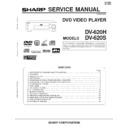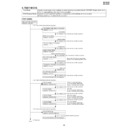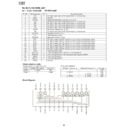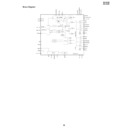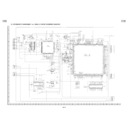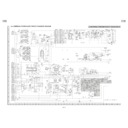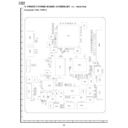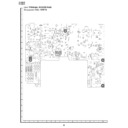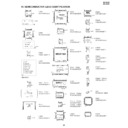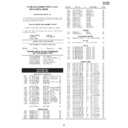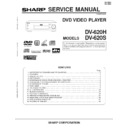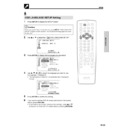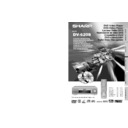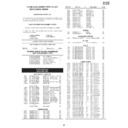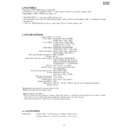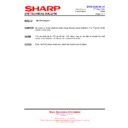Sharp DV-620 (serv.man2) Service Manual ▷ View online
DV-620H
DV-620S
DV-620S
9
6. DISASSEMBLY AND REPLACEMENT OF MAIN PARTS
6-1. DISASSEMBLY
1. Remove five screws (A), and remove the top cabinet.
Top Cabinet
(A)x2
(A)x1
(A)x2
t
j
k
t
r
r
o
p
s
o
p
(F)x4
(E)x2
Main PWB
s
j
k
7. Disconnect the lead line p and o and t and r from the main
PWB under the mechanism.
8. Remove two screws (E) on both sides of the terminal angle frame.
9. Remove four screws (F) of the main PWB.
10.Disconnect the lead line j and k and s from the main PWB.
2. Remove two screws (B).
3. Remove one screw (C).
4. Release the hooks of the front panel at two places on both sides
and three places on the bottom, and side the front panel toward
you.
5. Disconnect the connectors g and h .
6. Remove four screws (D) which installs the mechanical unit.
g
h
(D)x4
(B)x2
(C)x1
Fook x3
Fook x2
Mechanism
Front Panel
DV-620H
DV-620S
DV-620S
10
16.Remove the spacer (M).
*The spacer is bonded with both-side sticking tape.
17.Remove two screws, (N) of the decorative leg.
18.Push out the middle pin (O) of the setting leg in the direction
opposite to insertion (two places).
19.Remove one washer (P) and one nut (Q) which install the shuttle
knob.
20.Remove two screws (R) which install the power key PWB of the
front panel.
21.Remove three screws (S) which install the operate PWB of the
front panel.
11.Remove four screws (G).
12.Remove two screws (H), and remove the terminal of 21pin,
remove two connectors m , n .
13.Remove two screws (I) on both sides of the terminal angle frame.
14.Remove three screws (J) and release three hooks (K) which
install the terminal/power PWB.
15.Remove two screws (L) which install the display PWB.
f
f
m
n
m n
(I)x2
(K)x3
(J)x3
(L)x2
(G)x4
(H)x2
Terminal
Angle Frame
Angle Frame
Scart PWB
Display PWB
Terminal/Power
PWB
PWB
(S)x3
(P)x1
(Q)x1
(R)x2
(M)x1
(N)x2
(O)x2
Power Key PWB
Operate PWB
DV-620H
DV-620S
DV-620S
11
6-2. REPLACEMENT OF MAIN PARTS
<Take out disk>
1. Remove the top cabinet.
2. It is in such cases as the thin driver, and it is pushed in slowly, and a tray is drawn in the arrow direction the slide rack on the
2. It is in such cases as the thin driver, and it is pushed in slowly, and a tray is drawn in the arrow direction the slide rack on the
left of the base chassis.
3. Take out disk.
Front Side
<Disassembling and assembling the mechanism chassis>
1. Remove the four base chassis mounting screws.
2. Remove the loading motor lead wire and sled motor lead wire from the main PWB.
3. To protect the pickup against breakage by static electricity, turn the base chassis over with the pickup FFC connected and short-
2. Remove the loading motor lead wire and sled motor lead wire from the main PWB.
3. To protect the pickup against breakage by static electricity, turn the base chassis over with the pickup FFC connected and short-
circuit (solder) the short land of the superposition PWB.
4. Remove the pickup FFC from the main PWB.
5. Remove the pickup FFC from the superposition PWB.
6. Remove the traverse mounting screws to remove the traverse chassis ass'y.
Note: After assembly and wiring, remove the solder joint of the short land. If short-circuited, a disk is not played back.
5. Remove the pickup FFC from the superposition PWB.
6. Remove the traverse mounting screws to remove the traverse chassis ass'y.
Note: After assembly and wiring, remove the solder joint of the short land. If short-circuited, a disk is not played back.
1. Remove the pickup FPC and loading relay FFC A from the main PWB.
Note: Fit the conductive rubber cap to the front end of pickup FPC (short-circuit).
2. Remove the solder joint of loading relay PWB at drive unit rear side.
1
Sled motor lead wire (Yellow·Orange)
2
IN SW lead wire 2 (White)
3
Spindle motor lead wire (Red·Black)
4
Loading motor lead wire (Red·Black)
5
Remove each lead wire from the claw.
3. Remove the relay PWB mounting screw B (M2.6S + 6S S tight),
and remove the relay PWB C .
Sled Motor Lead Wire
Pickup FFC
Loading Motor Lead Wire
Traverse Fixing Screw
Superposition PWB
Pickup FFC
Short Land
<Replacing the pickup and the spindle motor>
Since the pickup optical axis and turntable inclination of DVD are adjusted with higher accuracy than of CD/MD, make a replacement
as a mechanism service chassis ass'y (refer to Parts List).
as a mechanism service chassis ass'y (refer to Parts List).
DV-620H
DV-620S
DV-620S
12
7. OPERATION OF PICKUP
7-1. CIRCUIT CONFIGURATION OF PICKUP
The pickup unit reads signals from the disk, and the flexible cable is connected to the board. The following signals flow through the
cable.
cable.
7-2. EQUIVALENT CIRCUIT OF PICKUP
7-3. POLARITIES OF SIGNAL
Focus
When electric current is flowed
FO+, FO-
from FO+ to FO-, the lens comes
to near the disk.
to near the disk.
Tracking
When electric current is flowed
TR+, TR-
from TR+ to TR-, the lens goes
toward the outer circumference.
toward the outer circumference.
FO+
TR–
TR+
FO–
ACTUATOR
OSC
V
OS
–
+
–
+
–
+
–
+
+
–
+
–
+
–
+
HOLOGRAM LASER UNIT
1
2
3
4
5
6
7
8
9
10
11
12
13
14
15
16
17
18
19
20
1
TR–
FO+
TR+
FO–
VR
PD
V
CC
GND
LD
GND
V
OS
NC
NC
V
ref
(VCC/2)
VA
VD
NC
GND
VB
VC
(NC)
Power adjust
HIGH-FREQUENCY CONVOLUTION
LD
PD
VA
VB
VC
VD
V
ref
V
cc
GND
7-4. SIGNALS OF PICKUP
7-4-1. Tracking drive signal (TR+, TR-)
The signal drives the tracking servo mechanism which projects the beam on the track by moving the objective lens (OL) to the outer
or inner circumference (at a right angle against the track) of the disk.
or inner circumference (at a right angle against the track) of the disk.
7-4-2. Focus drive signal (FO+, FO-)
The signal drives the focus servo mechanism which aligns the focus on the pit of the disk
by elevating OL (vertically against the disk surface.)
by elevating OL (vertically against the disk surface.)
The VR terminal is connected to GND.
2-focus objective lens
Actuator assembly
7-4-3. Monitor Diode (PD)
Since the laser diode largely varies output of the laser light even if the flowing current is slightly varied, the projection
light is detected with the monitor diode to control the laser light to be equally output.
Since the current varies on the monitor diode according to the intensity of the received light of the laser diode, the drive current of
the laser diode is reduced if the current of the monitor diode increases. On the contrary, the drive current of the laser diode is increased
if the current of the monitor diode decreases.
As the projection light of the laser diode becomes stronger, the current of the monitor diode increases to increase the current which
flows into the monitor diode output (PD). This is input to the pin 44 of IC302 and is compared with the reference voltage to control
the drive current of the laser diode.
The circuit is called ALPC (Automatic Laser Power Control).
light is detected with the monitor diode to control the laser light to be equally output.
Since the current varies on the monitor diode according to the intensity of the received light of the laser diode, the drive current of
the laser diode is reduced if the current of the monitor diode increases. On the contrary, the drive current of the laser diode is increased
if the current of the monitor diode decreases.
As the projection light of the laser diode becomes stronger, the current of the monitor diode increases to increase the current which
flows into the monitor diode output (PD). This is input to the pin 44 of IC302 and is compared with the reference voltage to control
the drive current of the laser diode.
The circuit is called ALPC (Automatic Laser Power Control).
7-4-4. Laser diode drive current control (LD)
Power supply to drive the laser diode
7-4-5. High-frequency convolution module power supply (VOSC)
The high-frequency convolution imposes the high-frequency signal on the DC current to impose the high frequency on the drive
current of the laser. Thus, the interference of outgoing light and reflected light is prevented.
current of the laser. Thus, the interference of outgoing light and reflected light is prevented.
LD
PD
7-4-6. HF Signal (VA, VB, VC, VD)
Signals recorded in the disk
When the quantity of laser light increases, the
current shown in figure increases and the PD
terminal voltage rises.
IC302 is used to control. The LD terminal voltage
lowers, and the quantity of light reduces. (IC302 is
actuated by voltage input.)
current shown in figure increases and the PD
terminal voltage rises.
IC302 is used to control. The LD terminal voltage
lowers, and the quantity of light reduces. (IC302 is
actuated by voltage input.)

